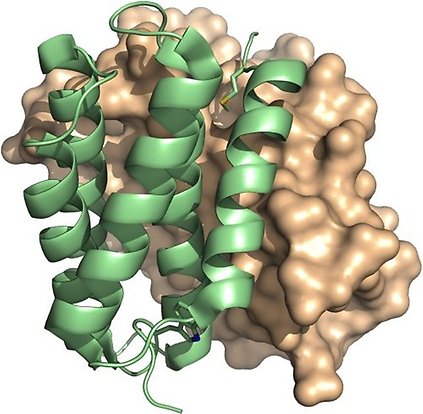Knight lab

Using a powerful combination of X-ray crystallography, molecular biology, and biophysical, biochemical, and computational techniques, we study how proteins and peptides bind to each other to form fibrillar structures such as spider silk, bacterial adhesive fimbriae, or amyloid. Our studies lay the foundation for further work to develop novel applications in medicine (e.g. novel ways for treating bacterial infections or amyloid diseases such as Alzheimer’s disease, Parkinson’s disease, and type 2 diabetes) and biotechnology (e.g. novel spider silk-based materials).
Popular science presentation
...
Research projects
Life processes depend critically on interactions between macromolecules. These interactions often involve coupled folding and binding, which lies at the heart of many biologically, medically, and technologically important processes and phenomena.
Research in my group focuses on three different systems that involve coupled binding and folding. Many pathogenic bacteria use hair-like structures called fimbriae to attach to host cells and initiate infection. The assembly of adhesive fimbriae via the chaperone/usher pathway provides an elegant example of how protein folding by Nature’s design may be coupled to binding in order to gain control over a complex assembly and secretion process. Spider silks, assembled in a complex process that links folding to polymerization, have extraordinary mechanical properties that make them attractive for development of novel materials. BRICHOS domains are used by mammalian cells to manage the problems associated with aggregation-prone peptides that must be partitioned away from amyloidogenic and potentially harmful pathways into biologically meaningful ones. Understanding how BRICHOS domains inhibit formation of toxic amyloid intermediates at the molecular level can pave the way for new ways of treating amyloid diseases such as Alzheimer’s disease, Parkinson’s disease, and type 2 diabetes.
We study these examples of coupled folding and binding using a powerful combination of X-ray crystallography and other diffraction-based techniques (SAXS, fibre diffraction) with molecular biology, biophysical, biochemical, and computational techniques. The knowledge generated from these studies will shed light on fundamental questions important for many biological processes. Such knowledge can also be used in the development of novel applications in medicine (e.g. novel ways for treating amyloid diseases and bacterial infections) and biotechnology (e.g. novel spider silk-based materials).
Group members
Publications
Molecular basis for different substrate-binding sites and chaperone functions of the BRICHOS domain
Part of Protein Science, 2024
- DOI for Molecular basis for different substrate-binding sites and chaperone functions of the BRICHOS domain
- Download full text (pdf) of Molecular basis for different substrate-binding sites and chaperone functions of the BRICHOS domain
Archaic chaperone-usher pili self-secrete into superelastic zigzag springs
Part of Nature, p. 335-+, 2022
- DOI for Archaic chaperone-usher pili self-secrete into superelastic zigzag springs
- Download full text (pdf) of Archaic chaperone-usher pili self-secrete into superelastic zigzag springs
MrpH, a new class of metal-binding adhesin, requires zinc to mediate biofilm formation
Part of PLoS Pathogens, 2020
- DOI for MrpH, a new class of metal-binding adhesin, requires zinc to mediate biofilm formation
- Download full text (pdf) of MrpH, a new class of metal-binding adhesin, requires zinc to mediate biofilm formation
Part of Acta Crystallographica Section D, p. 618-627, 2019
Diazirine-functionalized mannosides for photoaffinity labeling: trouble with FimH
Part of Beilstein Journal of Organic Chemistry, p. 1890-1900, 2018
- DOI for Diazirine-functionalized mannosides for photoaffinity labeling: trouble with FimH
- Download full text (pdf) of Diazirine-functionalized mannosides for photoaffinity labeling: trouble with FimH
Structural basis for Acinetobacter baumannii biofilm formation
Part of Proceedings of the National Academy of Sciences of the United States of America, p. 5558-5563, 2018
- DOI for Structural basis for Acinetobacter baumannii biofilm formation
- Download full text (pdf) of Structural basis for Acinetobacter baumannii biofilm formation
Structures of two fimbrial adhesins, AtfE and UcaD, from the uropathogen Proteus mirabilis
Part of Acta Crystallographica Section D, p. 1053-1062, 2018
Part of Microbiology, p. 672-683, 2016
Breaking the intestinal barrier to deliver drugs
Part of Science, p. 716-717, 2015
Part of PLoS biology, 2014
- DOI for Carbonic Anhydrase Generates CO2 and H+ That Drive Spider Silk Formation Via Opposite Effects on the Terminal Domains
- Download full text (pdf) of Carbonic Anhydrase Generates CO2 and H+ That Drive Spider Silk Formation Via Opposite Effects on the Terminal Domains
Part of Nature Communications, p. 3254, 2014
The BRICHOS Domain, Amyloid Fibril Formation, and Their Relationship
Part of Biochemistry, p. 7523-7531, 2013
Allosteric Mechanism Controls Traffic in the Chaperone/Usher Pathway
Part of Structure, p. 1861-1871, 2012
BRICHOS Domains Efficiently Delay Fibrillation of Amyloid beta-Peptide
Part of Journal of Biological Chemistry, p. 31608-31617, 2012
Part of Molecular Microbiology, p. 1100-1115, 2012
Part of Proceedings of the National Academy of Sciences of the United States of America, p. 2325-2329, 2012
Part of Journal of Molecular Biology, p. 294-308, 2012
Part of Journal of Molecular Biology, p. 477-487, 2012
Neutrophil elastase depends on serglycin proteoglycan for localization in granules
Part of Blood, p. 4478-4486, 2007
Resolving the energy paradox of chaperone/usher-mediated fibre assembly
Part of Biochemical Journal, p. 685-694, 2005
Part of Journal of Biological Chemistry, p. 33411-33418, 2005
Itch and skin rash from chocolate during fluoxetine and sertraline treatment: case report
Part of BMC Psychiatry, p. 36, 2004
RSPS version 4.0: a semi-interactive vector-search program for solving heavy-atom derivatives
Part of Acta Crystallographica Section D, p. 42-47, 2000
People
Telephone: +46 18 471 4554
fax: +46 18 530 396
e-mail: stefan.knight@icm.uu.se
Former group members
- Devapriya Choudhury (PhD student) (now at JNU, New Dehli)
- Jenny Mackenzie (nee Berglund) (PhD student) (now at Axis-Shield PoC AS, Oslo)
- Anton Zavialov (postdoc, assistant professor) (now at University of Turku, JBL, Turku)
- Anatoly Dubnovitsky (postdoc) (now at Karolinska Institutet, Stockholm)
- Glareh Askarieh (PhD student) (now at Medivir AB, Stockholm)
- Yu Xiaodi (“Dee") (PhD student) (now at The Scripps Research Institute, Boston)
- Wimal Ubhayasekera (senior scientist)

